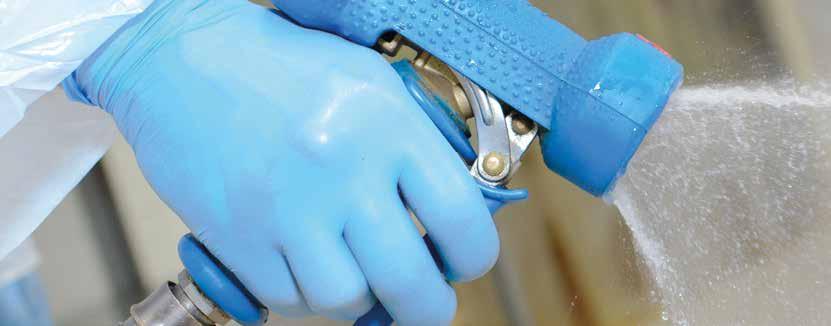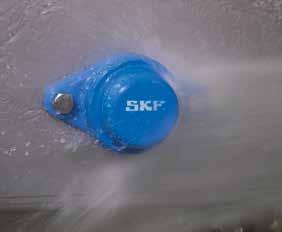
4 minute read
How clean are your bearings?
There’s one thing we expect of the food industry. Faultless hygiene. And rightly so too. But despite the gleaming surfaces we see on the exterior of our processing equipment, it’s the concealed bearings and their housings that often pose major issues.
But ironically, the washdown procedures that we implement to ensure our equipment is squeaky clean cause further issues, with water penetrating the seals, breaking down and emulsifying the grease, resulting in poor reliability and potential contamination.
Advertisement
To counteract such problems, SKF have reengineered the standard mounted bearing, designing the most hygienically stable units on the market, reducing risk to the environment and increasing cost-efficiency in the process. Contamination problems During washdown processes, food residues and bacteria can spread, potentially landing on bearing housings and creeping into gaps – no matter how small. The high pressure sprays can then help waterborne contamination spread even further.
The moist environment provides shelter for the breeding of micro-organisms, while progressively accumulating allergens and other contaminants. The subsequent pressure washing flushes them out, but only to other areas. Jet sprays can then lift contamination into the air, producing aerosols, which later settle and infect more surfaces. And that’s just on the outside.
The caustics and detergents entering the bearing cavities cause corrosion, and the grease breakdown leads to the requirement of more frequent lubricant replenishment. The relubrication process then purges the old spent grease out of the housing, increasing the potential of contamination with excess grease attaching to cloths and gloves used in the dry-cleaning process.
Bearing protection. Patented Underlined with six new patented submissions and three design protections, the SKF Food Line – Blue Range can be the answer to many of these problems. Relubrication-free, each unit is filled with purpose-designed, food-grade, allergen-free grease that is contained safely and protected by effective sealing technology.
A completely new approach to bearing sealing
Manufactured from inert, chemical-resistant hydrophobic polypropylene (PP), with long glass fibre for additional strength, they’re designed with hygienic smooth surfaces, purposely shaped for self-draining. And if damaged, the distinctive food-grade blue colour is easy to detect optically.
An innovative rubber base seal is injected into the housing and co-moulded to fill the gaps between the structure and machine frame. A stop limiter around the housing bushes allows optimal bolt tightening torque, while maintaining a hygienic seal.

Material wastage is reduced
A blue PP anchoring and sealing end cover are securely twist-locked into place, with indicator dots to signify correct positioning. The back seal, also moulded from blue PP, prevents the entry of contaminants into the bearing unit via the shaft. It provides static sealing against the housing and dynamic, and rotary sealing against the shaft, with no spring components to accidentally enter the foodstuffs.
Then there’s the ‘Gutter Concept.’ A completely new approach to bearing sealing. Accepting that caustics and detergents contained in industrial cleaning products are specifically designed to pass through barriers, this solution blocks the majority but handles the remainder in a truly innovative manner. The drops that enter via the seal’s top lip are guided around the multiple gutters, away from the bearing enclosure, then exit from the opposite, bottom side of the seal.
Resulting in a 30% water saving
Raising the bar in hygiene Rigorous testing, both in-house and by third-party, against standard products have proved that the Food Line – Blue Range has made significant advancements in hygienic design. In particular, during one test by RISE (Research Institute of Sweden), sour milk that was brushed onto bearing housings was cleaned off by a typical detergent pressure wash, and even compared to SKF’s own highest standards, the end cover and back seal outperformed previous tests, resulting in a 30% water saving. A specific high-pressure wash test was developed for the end cover, bearing gutter seal and base seal incorporated into the Food Line – Blue Range, which showed no water ingress when high pressure water was applied at close distances unlike most competitors’ units. The back seal is designed to maximise sealing efficiency and in turn will generate friction. However, whilst in friction torque machine tests, more friction than standard market solutions was noted, and operating temperature remained comparable.
The ‘Droplet Test’ was also devised to test the grease and bearing sealing system. Across 500 hours of operation, with constant dripping of standard industry, caustic laden cleaning fluids at 30% concentration, the
SKF seal was proven to contain the fluids to the outside gutters, allowing virtually no contamination into the bearing enclosure and raceways emerged almost new. Friction torque testing was also undertaken and established that the ‘gutter sealing concept’ had superior energy efficiency and lower operating temperatures. Positively changing culture Material wastage is reduced courtesy of longer-lasting, better-protected bearings, therefore fewer replacement units are required. With no relubrication or leaking grease, additional consumption of spill control and gloves is avoided. Cleaning no longer takes up such large volumes of water, and wastewater recycling is easier. Excellent recyclability and energy recovery properties align to reduce bearing and grease consumption, lower carbon emissions, improve energy savings, and provide zero landfill. An avoidable-orientated manufacturing culture, rather than a disposalorientated ethos, can now be positively enforced.
With these small steps and continuous savings taken together, you’d find it hard not to put forward a strong economic case for switching to SKF’s hygienically designed Food Line – Blue Range.

